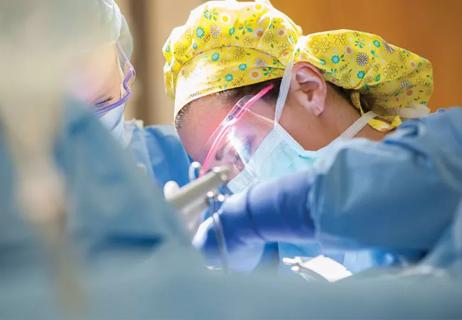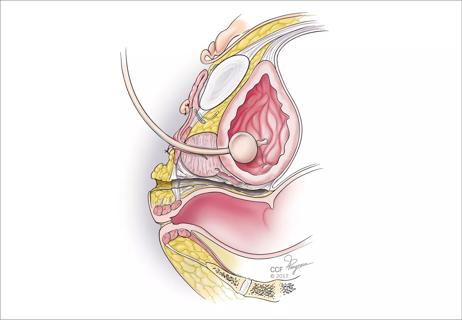Study assesses costs and benefits

Pelvic organ prolapse is a common problem in women, particularly those over 45, and is rising as the population ages and obesity rates increase. One commonly performed prolapse repair procedure is a hysterectomy with native-tissue prolapse repair.
Cleveland Clinic is a non-profit academic medical center. Advertising on our site helps support our mission. We do not endorse non-Cleveland Clinic products or services. Policy
But in the past decade, as more women have expressed interest in retaining their uterus, uterus preserving procedures, such as sacrospinous hysteropexy, have become more popular. Studies report that more than half of women with pelvic organ prolapse would prefer uterine preserving surgery if the outcome was the same.
Uterine preservation has some advantages, including shorter surgical time, less blood loss, faster recovery, avoidance of an unnecessary procedure and fertility maintenance. However, unlike hysterectomy, uterine preservation cannot prevent cervical or endometrial cancer or postmenopausal bleeding. There is also less outcome data.
In deciding which procedure to choose, providers and patients have to weigh the relative risks of prolapse recurrence, future endometrial pathology and costs. At Cleveland Clinic, only women without risk factors are candidates for hysteropexy.
To better understand the costs and benefits of the two approaches, Cleveland Clinic Ob/Gyn & Women’s Health Institute, in collaboration with Providence St. John’s Health Center and Trinity Health of New England, conducted a cost-effectiveness analysis comparing vaginal hysterectomy with uterosacral ligament suspension (TVH/USLS) with sacrospinous ligament suspension hysteropexy (HPXY). “We wanted to offer an additional perspective to guide patients, providers and healthcare organizations in determining whether it is cost-effective to perform a hysterectomy at the time of prolapse repair,” says Oliva Chang, MD, MPH, a fellow in Female Pelvic Medicine and Reconstructive Surgery at Cleveland Clinic.
The findings will be presented at the 2019 American Urogynecologic Society and International Urogynecological Association Joint Scientific Meeting.
The researchers used a decision analysis tool to model prolapse recurrence following TVH/USLS and HPXY, which was treated with minimally invasive sacrocolpopexy with hysterectomy if the uterus was still present. They also created models for the incidence and diagnostic evaluation of postmenopausal bleeding, including risk of endometrial pathology (polyps/hyperplasia), and diagnosis or death from endometrial cancer. Beyond the cost of the index procedure, the analysis looked at potential costs associated with subsequent prolapse repair, endometrial biopsy, pelvic ultrasound, hysteroscopy with or without dilation and curettage, and treatment of endometrial cancer. The costs and probabilities of outcomes were gathered from Medicare reimbursement data and published literature.
TVH/USLS costs on average $587.61 more than HPXY per case of prolapse. But TVH/USLS prevents 1.1% of women from post-menopausal bleeding and diagnostic evaluation and 1% of women from undergoing subsequent major surgery for the treatment of either prolapse or cancer. The model calculated the cost of treating endometrial cancer at $2,698,677; this makes TVH/USLS a cost-effective treatment in preventing death from endometrial cancer. “Despite the low incidence of endometrial cancer among prolapse patients, hysterectomy is cost-effective because of the high costs of treating the cancer,” says Dr. Chang.
“Cost-effectiveness is not the only consideration when treating a quality of life disorder like pelvic organ prolapse,” says Beri Ridgeway, MD, study co-author and Institute Chair of Ob/Gyn and Women’s Health. To learn more about women’s preferences regarding uterus preservation, the Ob/Gyn & Women’s Health Institute is currently surveying all new gynecologic patients over 45 about how they feel about their uterus and factors that contribute to their opinion.

Deprivation is linked to impaired glucose intolerance and racial disparities

Artesunate ointment is safe well and tolerated patients with vulvar intraepithelial neoplasia

A case-based discussion of efficacy, eligibility and use

Workshop curriculum was valued by some, while others would have preferred time for themselves

Study finds lower incidence of endometriosis than in cisgender patients

Large randomized study compares embryo growth kinetics and live birth rates between culture media

Surgeon experience is key to reducing adverse events

Introducing Laura Detti, MD, newly appointed Chair of the Department of Subspecialty Care for Women’s Health